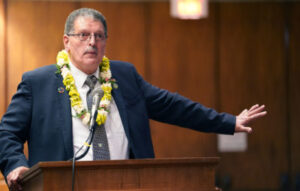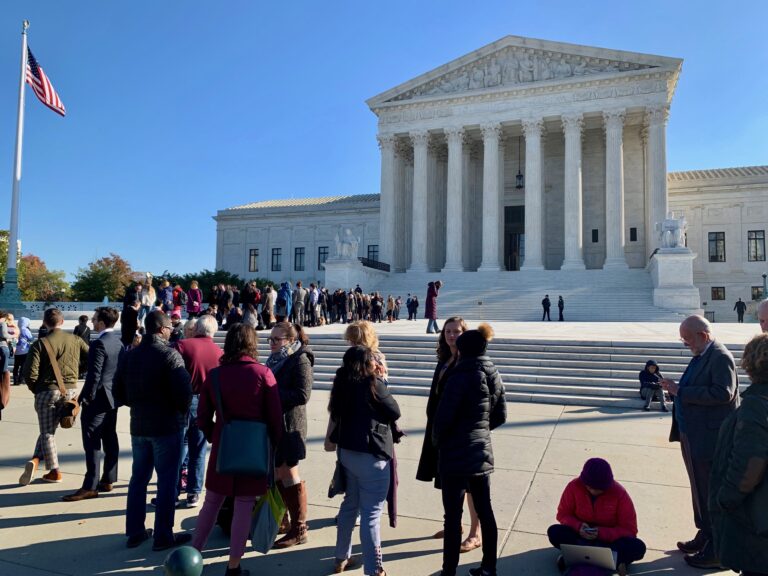Honolulu Civil Beat | April 23rd, 2020.
By Nick Grube
UPDATED: The decision averted what many environmentalists feared was a gutting of the Clean Water Act.
WASHINGTON — The U.S. Supreme Court ruled Thursday that Maui County can’t skirt the Clean Water Act by merely pumping its sewage into groundwater before discharging it into the ocean.
In a 6-3 opinion written by Associate Justice Stephen Breyer, the majority ruled that Maui County, like other municipalities and businesses dumping pollutants into the nation’s rivers, lakes and oceans, must have a permit to do so.
The ruling is both a rebuke of Maui County and the Trump administration, which had joined the county in arguing that the Clean Water Act should only cover waste that was discharged directly into navigable waters, and not pollutants that were first filtered through groundwater before reaching their final destination.
Breyer wrote that following such logic, however, would blow a “massive loophole” in the Clean Water Act and allow for “easy evasion.”
“This is a huge win for people all across this country who are concerned about protecting the waters of the United States and protecting clean water,” said David Henkin, the Honolulu-based attorney for Earthjustice who argued against Maui County in November.
“I’m thrilled. This is not a narrow win. This is a six-vote majority. The court very clearly said that there is no loophole to use our groundwater as a sewer.”
The majority included associate justices Breyer, Elena Kagan, Ruth Bader Ginsberg and Sonia Sotomayor. Chief Justice John Roberts and Associate Justice Brett Kavanaugh, both of whom are considered conservative, were also in the majority.
Justices Clarence Thomas, Samuel Alito and Neil Gorsuch dissented.
The case revolves around a Maui County wastewater treatment plan in Lahaina that pumps millions of gallons of treated sewage into the groundwater each day using underground injection wells.
That groundwater, mixed with treated sewage, then travels underground and seeps into the ocean where studies have shown that it promotes algae growth that suffocates and kills the coral reefs and other marine life.
Several environmental groups, including the Hawaii Wildlife Fund, Sierra Club-Maui Group, Surfrider Foundation and West Maui Preservation Association, filed a lawsuit in 2012, saying that the county needed a permit under the Clean Water Act if it was going to discharge pollutants into a federal waterway. The lower courts agreed, citing long-standing interpretations of the law.
Maui County, however, pushed the case to the Supreme Court in 2018, finding an ally in President Donald Trump, whose administration has made reversing decades of environmental regulation a top priority.
The administration joined the case and latched on to Maui County’s argument that it did not need a permit because it was not discharging waste directly into the ocean, but instead mixing it with groundwater that then percolated out to sea.
This “who touched it last” theory also rallied fossil fuel companies and other major industry polluters, several of which wrote legal briefs in support of Maui County and the administration.
Among those backing Maui County were the American Petroleum Institute, the National Mining Association and Energy Transfer Partners, the company behind the Dakota Access Pipeline project that spurred months-long protests at the Standing Rock Sioux reservation in North Dakota.
Earthjustice and the environmental groups, on the other hand, had the support of scientists, law professors and a number of former U.S. Environmental Protection Agency officials, including three top administrators who served under Democratic and Republican presidents.
The case has divided the Maui County government.
In September, the Maui County Council voted 5-4 to settle the case before the Supreme Court heard oral arguments. The hope at the time was to avoid a high stakes showdown that could result in severely weakening the Clean Water Act, one of the country’s premier environmental protection laws.
Maui Mayor Michael Victorino and his top attorney, Moana Lutey, refused to accept the settlement, which sparked a legal battle over divisions of power that has since been dismissed.
Maui County Councilwoman Kelly King, who supported a settlement, said she was relieved by Thursday’s ruling although she’s disappointed that it has cost the county millions of dollars in legal fees.
“This case should have never gone to the Supreme Court in the first place,” King said. “This was a scary thing. This lawsuit could have enabled more pollution in our waterways across the country and in Maui.”
Henkin pointed out that the majority opinion undercut the “alarmist rhetoric” put forth by lawyers for Maui County and the Trump administration who argued that an adverse ruling would somehow expand the scope of the Clean Water Act by, for instance, going after homeowners with leaky septic tanks and requiring permits for millions of Americans.
This same message was repeated by Victorino, who said he was simply seeking “clarity in the law” and dismissed any concerns that a victory could gut the Clean Water Act and lead to more widespread pollution.
 David Henkin, of Earthjustice, argued before the Supreme Court in November. Nick Grube/Civil Beat
David Henkin, of Earthjustice, argued before the Supreme Court in November. Nick Grube/Civil Beat
 Maui Mayor Mike Victorino speaks to joint WAM Finance committees at the 2020 Legislature Cory Lum/Civil Beat/2020
Maui Mayor Mike Victorino speaks to joint WAM Finance committees at the 2020 Legislature Cory Lum/Civil Beat/2020
The opinion stated that in 30 years of the EPA overseeing federal discharge permitting “we have seen no evidence of unmanageable expansion.”
And even if the EPA or a state government did decide to go after an individual bad actor, the justices said, the courts “can mitigate any hardship or injustice when they apply the statute’s penalty provision.”
Federal judges, they said, have broad discretion when it comes to weighing the seriousness of the offense against good faith efforts to comply with the law as well as the economic impact a penalty might have on someone who falls out of line.
“They called the county and their industry allies out on all of their scare tactics and said, ‘No, the way the Clean Water Act has been administered over 30 years does not have this parade of horribles in it,’” Henkin said. “I think this is really going to take the wind out of the sails of big polluter defendants.”
He said the case will now go back to the lower courts for judges there to decide whether Maui County needs a permit.
If those judges go along with their previous rulings then the county will likely need to develop a plan to cut down on the amount of pollution it sends into the ocean, whether it’s diverting the treated wastewater to golf courses and agriculture or improving the sewage treatment process.
Henkin said it’s possible the county could continue to fight in the lower courts, something that could cause years of additional delay and more cost to the taxpayers. So far, Maui County has already approved spending $4.3 million on outside legal counsel.
“The mayor said he wanted clarity from the Supreme Court and he got that clarity, which from our perspective is looking pretty good,” Henkin said. “We do encourage the county to focus on fixing the problem rather than spending more money on lawyers fighting what we still believe is a losing battle.”
For his part, Victorino did not view the ruling as a defeat. To the contrary, in a press release, he said the Supreme Court’s opinion was “a step toward the clarity we have advocated for.”
Victorino played up the fact that the Supreme Court didn’t expressly say the county needed a pollution discharge permit, although most signs — including previous lower court rulings and Thursday’s opinion that found Maui County’s interpretation of the law “unreasonable” — point in that direction.
“We look forward to further clarity from our local regulators and working collaboratively to protect our waters,” Victorino said.
Original article URL: https://www.civilbeat.org/2020/04/us-supreme-court-rules-against-maui-in-major-clean-water-case/

